Accounting Coursework: Tesco Plc and LMU Plc Financial Analysis Report
VerifiedAdded on 2020/10/05
|12
|1884
|318
Report
AI Summary
This report provides a comprehensive analysis of the financial performance of Tesco Plc and LMU Plc. The analysis begins with an examination of Tesco Plc's financial health using accounting ratios from 2015 to 2017, including gross profit margin, return on total assets, return on capital employed, current ratio, liquidity ratio, stock turnover, and gearing ratio. It also discusses the limitations of these ratios and factors affecting Tesco in 2017. The report then shifts its focus to LMU Plc, evaluating two investment models (Super and Deluxe) using investment appraisal techniques like payback period, accounting rate of return (ARR), net present value (NPV), and internal rate of return (IRR). The report concludes with recommendations based on these techniques, suggesting the Super model is a more viable investment. The report includes tables and calculations for each technique and references relevant sources.
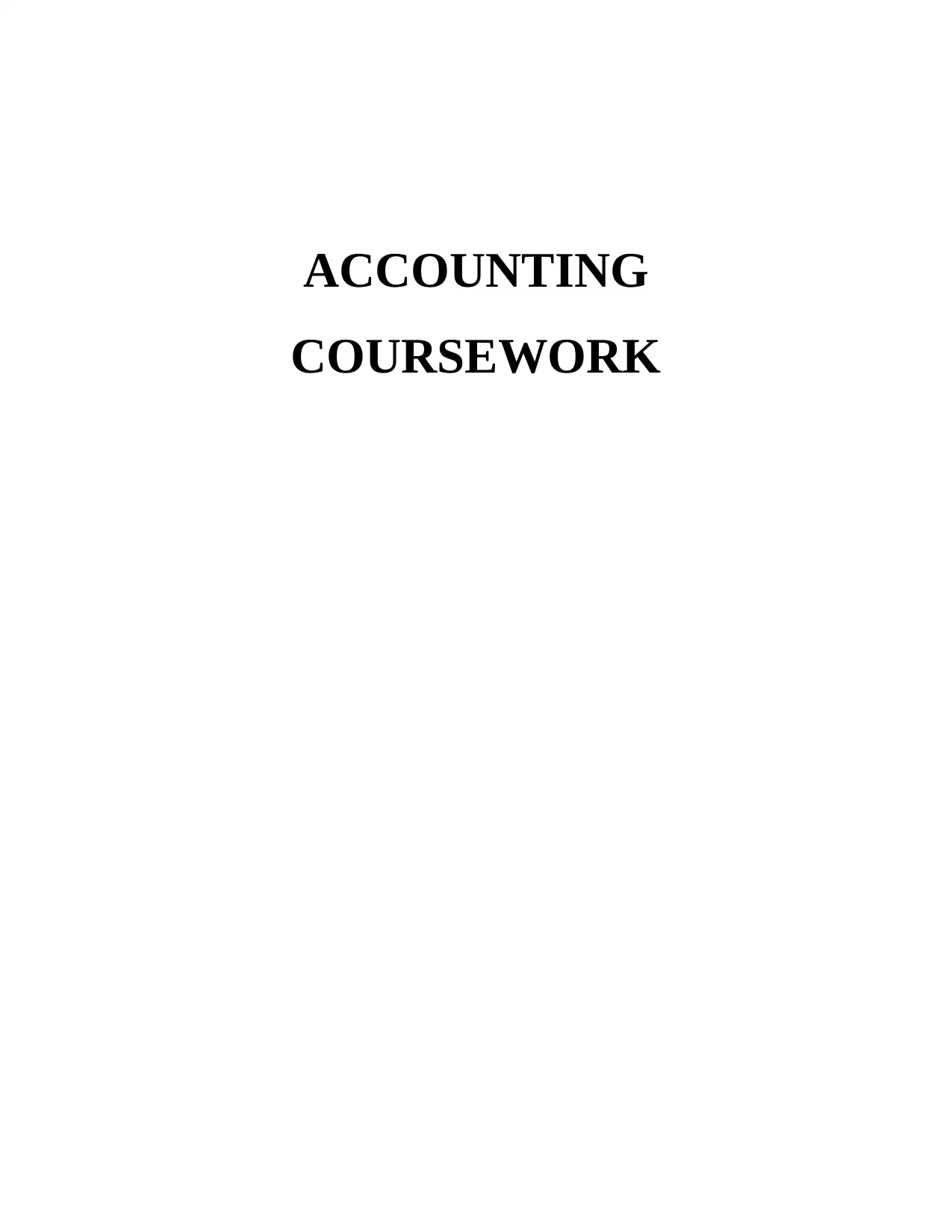
ACCOUNTING
COURSEWORK
COURSEWORK
Paraphrase This Document
Need a fresh take? Get an instant paraphrase of this document with our AI Paraphraser
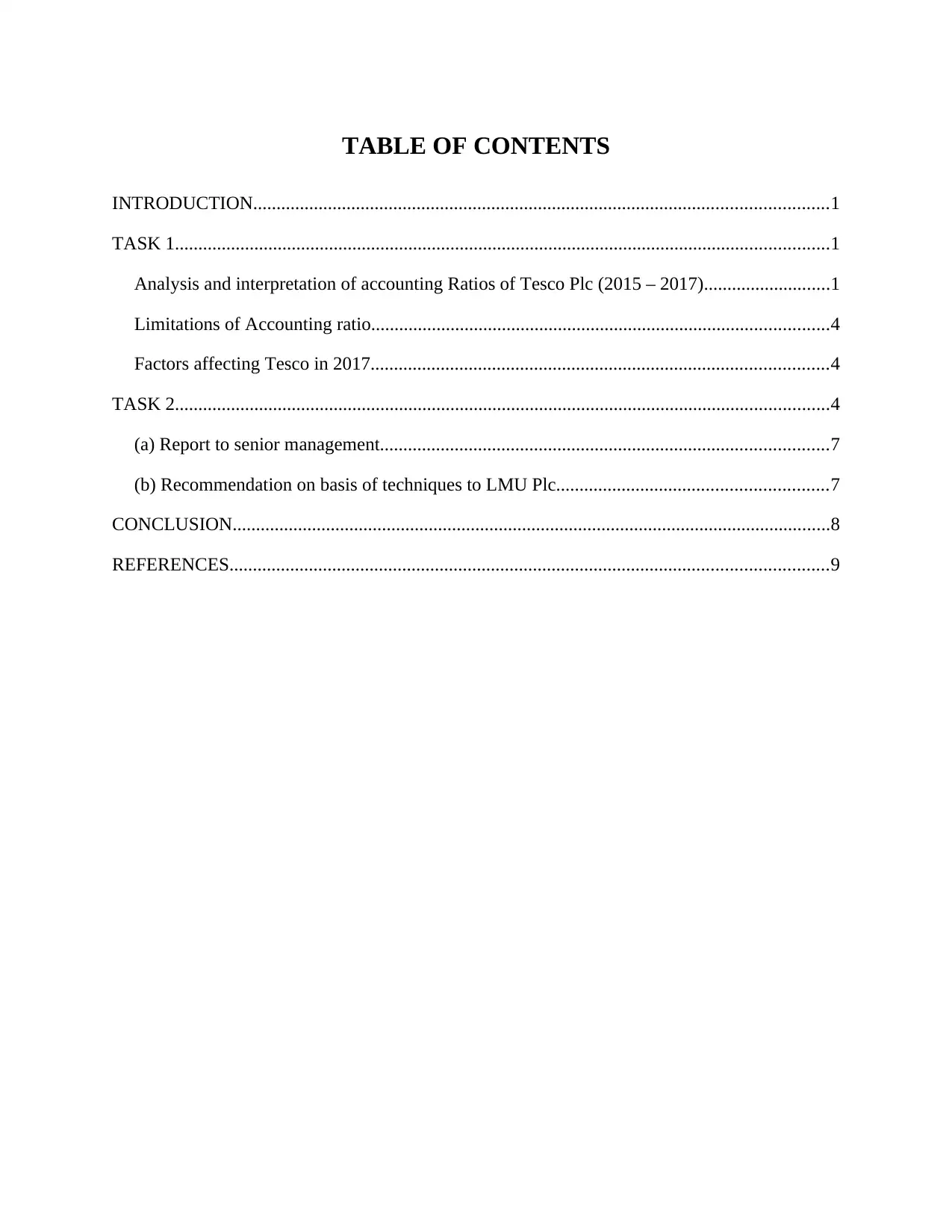
TABLE OF CONTENTS
INTRODUCTION...........................................................................................................................1
TASK 1............................................................................................................................................1
Analysis and interpretation of accounting Ratios of Tesco Plc (2015 – 2017)...........................1
Limitations of Accounting ratio..................................................................................................4
Factors affecting Tesco in 2017..................................................................................................4
TASK 2............................................................................................................................................4
(a) Report to senior management................................................................................................7
(b) Recommendation on basis of techniques to LMU Plc..........................................................7
CONCLUSION................................................................................................................................8
REFERENCES................................................................................................................................9
INTRODUCTION...........................................................................................................................1
TASK 1............................................................................................................................................1
Analysis and interpretation of accounting Ratios of Tesco Plc (2015 – 2017)...........................1
Limitations of Accounting ratio..................................................................................................4
Factors affecting Tesco in 2017..................................................................................................4
TASK 2............................................................................................................................................4
(a) Report to senior management................................................................................................7
(b) Recommendation on basis of techniques to LMU Plc..........................................................7
CONCLUSION................................................................................................................................8
REFERENCES................................................................................................................................9
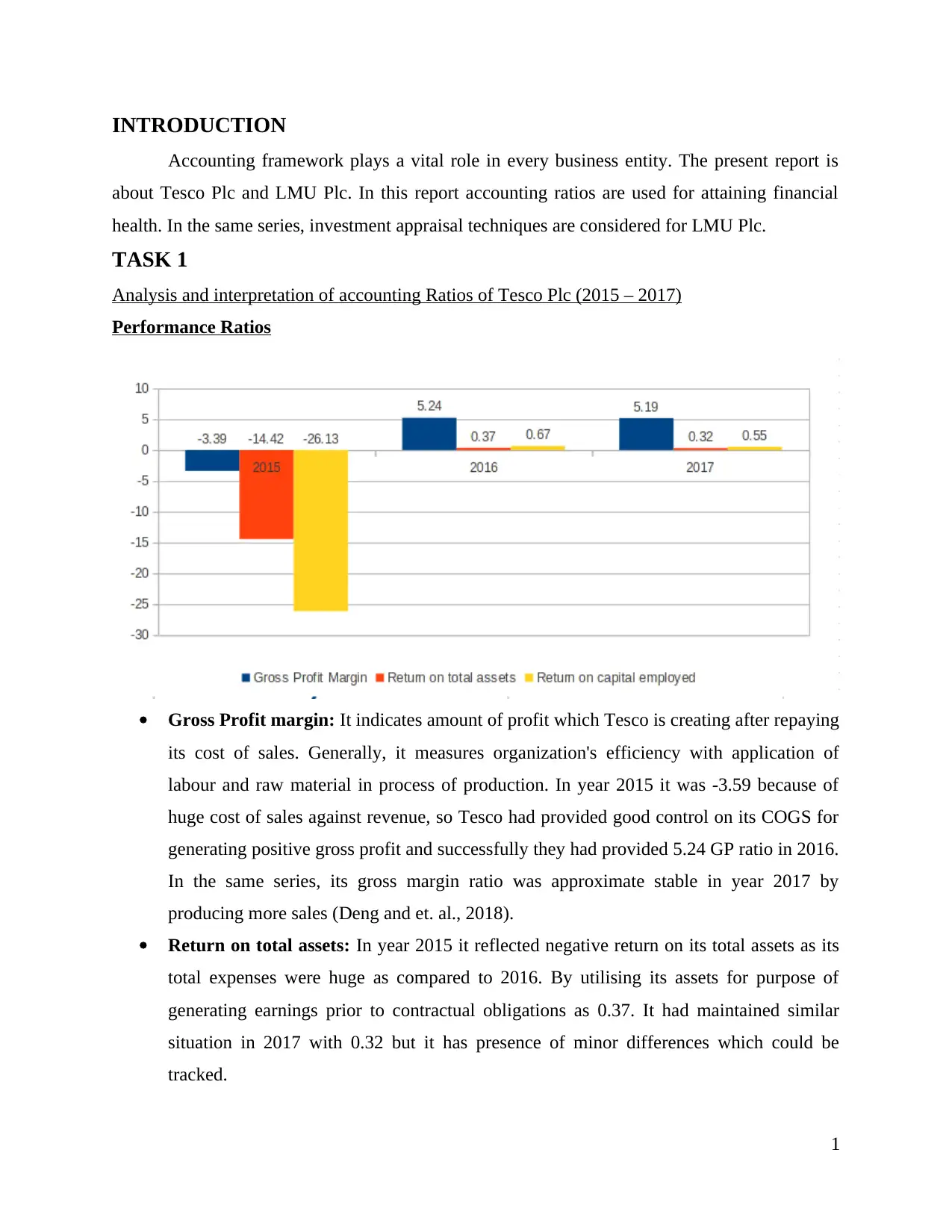
INTRODUCTION
Accounting framework plays a vital role in every business entity. The present report is
about Tesco Plc and LMU Plc. In this report accounting ratios are used for attaining financial
health. In the same series, investment appraisal techniques are considered for LMU Plc.
TASK 1
Analysis and interpretation of accounting Ratios of Tesco Plc (2015 – 2017)
Performance Ratios
Gross Profit margin: It indicates amount of profit which Tesco is creating after repaying
its cost of sales. Generally, it measures organization's efficiency with application of
labour and raw material in process of production. In year 2015 it was -3.59 because of
huge cost of sales against revenue, so Tesco had provided good control on its COGS for
generating positive gross profit and successfully they had provided 5.24 GP ratio in 2016.
In the same series, its gross margin ratio was approximate stable in year 2017 by
producing more sales (Deng and et. al., 2018).
Return on total assets: In year 2015 it reflected negative return on its total assets as its
total expenses were huge as compared to 2016. By utilising its assets for purpose of
generating earnings prior to contractual obligations as 0.37. It had maintained similar
situation in 2017 with 0.32 but it has presence of minor differences which could be
tracked.
1
Accounting framework plays a vital role in every business entity. The present report is
about Tesco Plc and LMU Plc. In this report accounting ratios are used for attaining financial
health. In the same series, investment appraisal techniques are considered for LMU Plc.
TASK 1
Analysis and interpretation of accounting Ratios of Tesco Plc (2015 – 2017)
Performance Ratios
Gross Profit margin: It indicates amount of profit which Tesco is creating after repaying
its cost of sales. Generally, it measures organization's efficiency with application of
labour and raw material in process of production. In year 2015 it was -3.59 because of
huge cost of sales against revenue, so Tesco had provided good control on its COGS for
generating positive gross profit and successfully they had provided 5.24 GP ratio in 2016.
In the same series, its gross margin ratio was approximate stable in year 2017 by
producing more sales (Deng and et. al., 2018).
Return on total assets: In year 2015 it reflected negative return on its total assets as its
total expenses were huge as compared to 2016. By utilising its assets for purpose of
generating earnings prior to contractual obligations as 0.37. It had maintained similar
situation in 2017 with 0.32 but it has presence of minor differences which could be
tracked.
1
⊘ This is a preview!⊘
Do you want full access?
Subscribe today to unlock all pages.

Trusted by 1+ million students worldwide
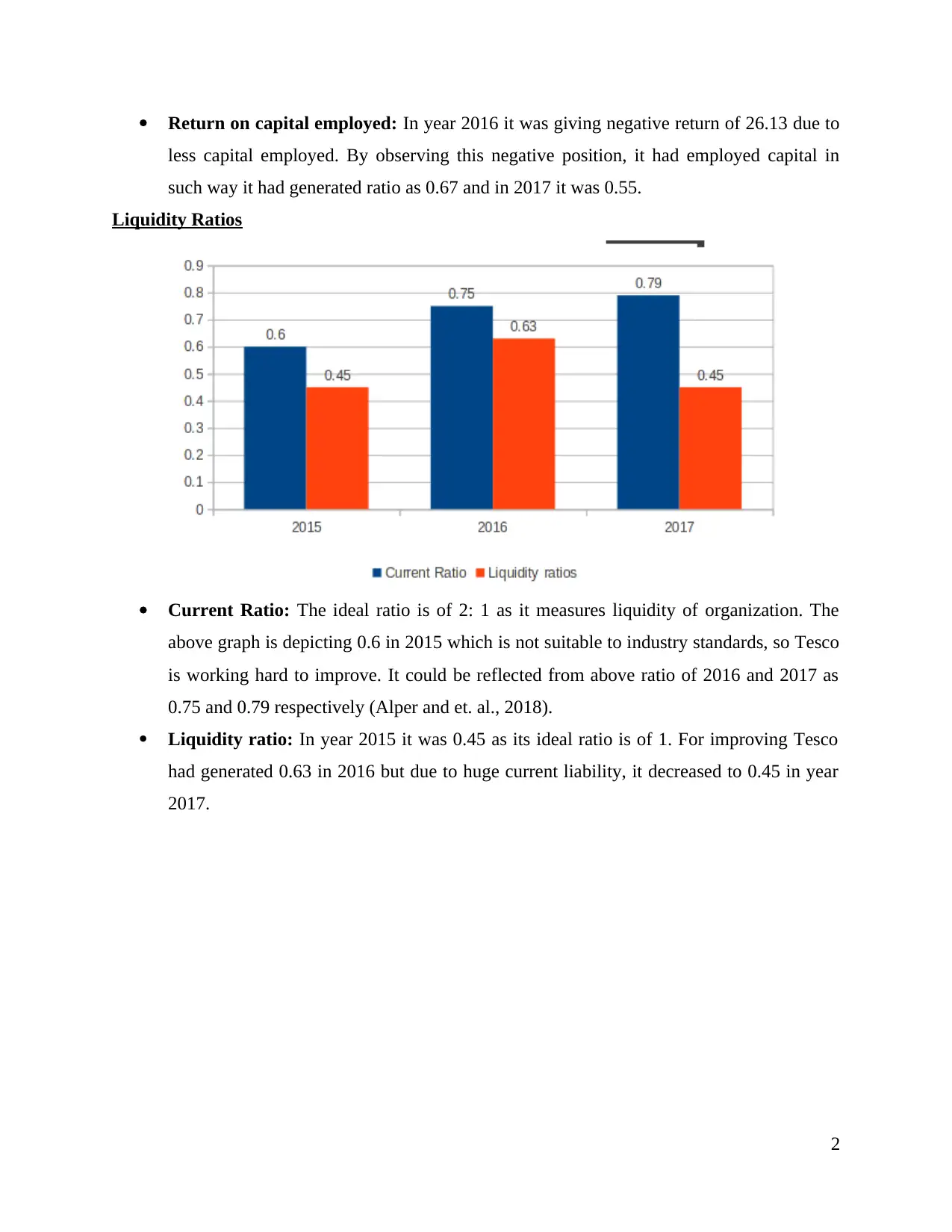
Return on capital employed: In year 2016 it was giving negative return of 26.13 due to
less capital employed. By observing this negative position, it had employed capital in
such way it had generated ratio as 0.67 and in 2017 it was 0.55.
Liquidity Ratios
Current Ratio: The ideal ratio is of 2: 1 as it measures liquidity of organization. The
above graph is depicting 0.6 in 2015 which is not suitable to industry standards, so Tesco
is working hard to improve. It could be reflected from above ratio of 2016 and 2017 as
0.75 and 0.79 respectively (Alper and et. al., 2018).
Liquidity ratio: In year 2015 it was 0.45 as its ideal ratio is of 1. For improving Tesco
had generated 0.63 in 2016 but due to huge current liability, it decreased to 0.45 in year
2017.
2
less capital employed. By observing this negative position, it had employed capital in
such way it had generated ratio as 0.67 and in 2017 it was 0.55.
Liquidity Ratios
Current Ratio: The ideal ratio is of 2: 1 as it measures liquidity of organization. The
above graph is depicting 0.6 in 2015 which is not suitable to industry standards, so Tesco
is working hard to improve. It could be reflected from above ratio of 2016 and 2017 as
0.75 and 0.79 respectively (Alper and et. al., 2018).
Liquidity ratio: In year 2015 it was 0.45 as its ideal ratio is of 1. For improving Tesco
had generated 0.63 in 2016 but due to huge current liability, it decreased to 0.45 in year
2017.
2
Paraphrase This Document
Need a fresh take? Get an instant paraphrase of this document with our AI Paraphraser
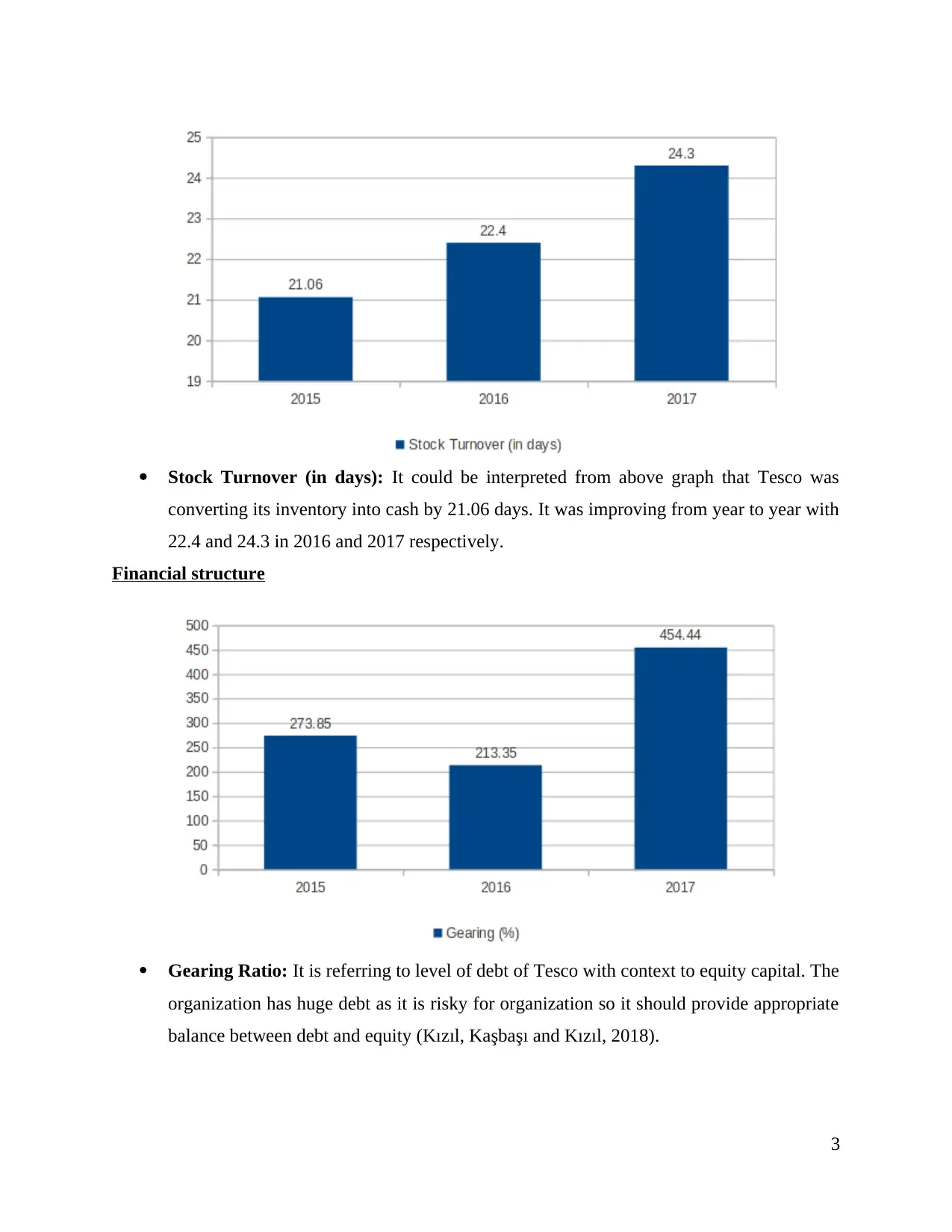
Stock Turnover (in days): It could be interpreted from above graph that Tesco was
converting its inventory into cash by 21.06 days. It was improving from year to year with
22.4 and 24.3 in 2016 and 2017 respectively.
Financial structure
Gearing Ratio: It is referring to level of debt of Tesco with context to equity capital. The
organization has huge debt as it is risky for organization so it should provide appropriate
balance between debt and equity (Kızıl, Kaşbaşı and Kızıl, 2018).
3
converting its inventory into cash by 21.06 days. It was improving from year to year with
22.4 and 24.3 in 2016 and 2017 respectively.
Financial structure
Gearing Ratio: It is referring to level of debt of Tesco with context to equity capital. The
organization has huge debt as it is risky for organization so it should provide appropriate
balance between debt and equity (Kızıl, Kaşbaşı and Kızıl, 2018).
3
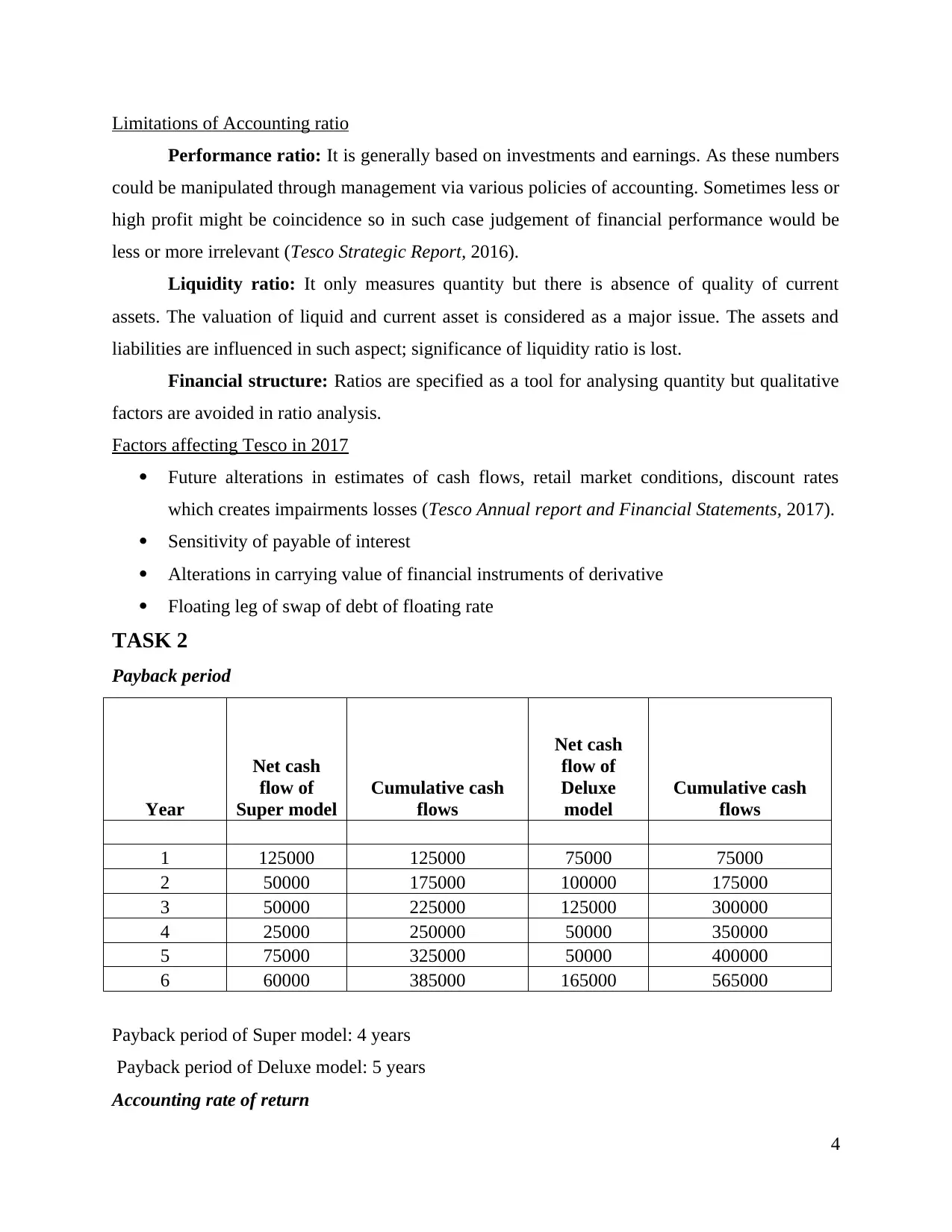
Limitations of Accounting ratio
Performance ratio: It is generally based on investments and earnings. As these numbers
could be manipulated through management via various policies of accounting. Sometimes less or
high profit might be coincidence so in such case judgement of financial performance would be
less or more irrelevant (Tesco Strategic Report, 2016).
Liquidity ratio: It only measures quantity but there is absence of quality of current
assets. The valuation of liquid and current asset is considered as a major issue. The assets and
liabilities are influenced in such aspect; significance of liquidity ratio is lost.
Financial structure: Ratios are specified as a tool for analysing quantity but qualitative
factors are avoided in ratio analysis.
Factors affecting Tesco in 2017
Future alterations in estimates of cash flows, retail market conditions, discount rates
which creates impairments losses (Tesco Annual report and Financial Statements, 2017).
Sensitivity of payable of interest
Alterations in carrying value of financial instruments of derivative
Floating leg of swap of debt of floating rate
TASK 2
Payback period
Year
Net cash
flow of
Super model
Cumulative cash
flows
Net cash
flow of
Deluxe
model
Cumulative cash
flows
1 125000 125000 75000 75000
2 50000 175000 100000 175000
3 50000 225000 125000 300000
4 25000 250000 50000 350000
5 75000 325000 50000 400000
6 60000 385000 165000 565000
Payback period of Super model: 4 years
Payback period of Deluxe model: 5 years
Accounting rate of return
4
Performance ratio: It is generally based on investments and earnings. As these numbers
could be manipulated through management via various policies of accounting. Sometimes less or
high profit might be coincidence so in such case judgement of financial performance would be
less or more irrelevant (Tesco Strategic Report, 2016).
Liquidity ratio: It only measures quantity but there is absence of quality of current
assets. The valuation of liquid and current asset is considered as a major issue. The assets and
liabilities are influenced in such aspect; significance of liquidity ratio is lost.
Financial structure: Ratios are specified as a tool for analysing quantity but qualitative
factors are avoided in ratio analysis.
Factors affecting Tesco in 2017
Future alterations in estimates of cash flows, retail market conditions, discount rates
which creates impairments losses (Tesco Annual report and Financial Statements, 2017).
Sensitivity of payable of interest
Alterations in carrying value of financial instruments of derivative
Floating leg of swap of debt of floating rate
TASK 2
Payback period
Year
Net cash
flow of
Super model
Cumulative cash
flows
Net cash
flow of
Deluxe
model
Cumulative cash
flows
1 125000 125000 75000 75000
2 50000 175000 100000 175000
3 50000 225000 125000 300000
4 25000 250000 50000 350000
5 75000 325000 50000 400000
6 60000 385000 165000 565000
Payback period of Super model: 4 years
Payback period of Deluxe model: 5 years
Accounting rate of return
4
⊘ This is a preview!⊘
Do you want full access?
Subscribe today to unlock all pages.

Trusted by 1+ million students worldwide
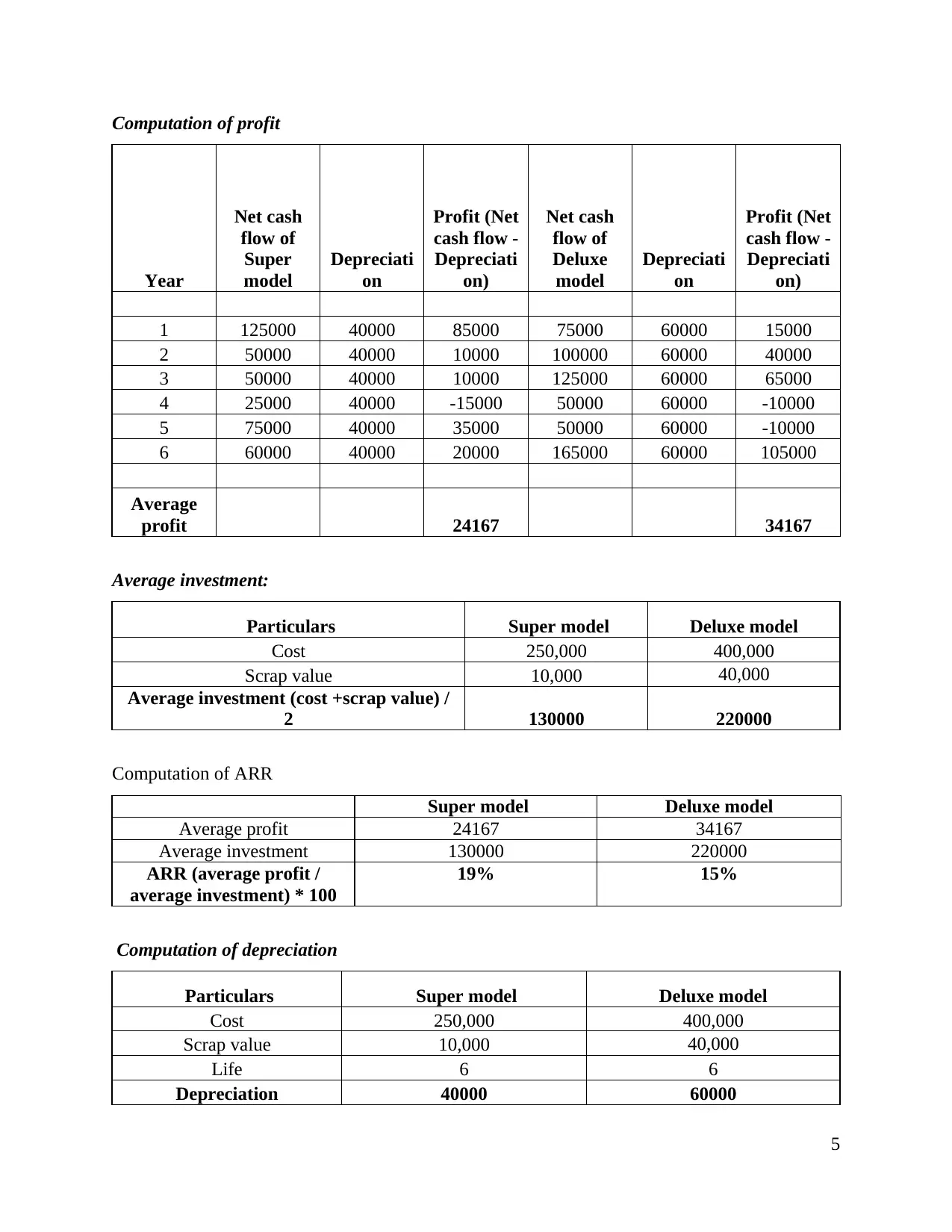
Computation of profit
Year
Net cash
flow of
Super
model
Depreciati
on
Profit (Net
cash flow -
Depreciati
on)
Net cash
flow of
Deluxe
model
Depreciati
on
Profit (Net
cash flow -
Depreciati
on)
1 125000 40000 85000 75000 60000 15000
2 50000 40000 10000 100000 60000 40000
3 50000 40000 10000 125000 60000 65000
4 25000 40000 -15000 50000 60000 -10000
5 75000 40000 35000 50000 60000 -10000
6 60000 40000 20000 165000 60000 105000
Average
profit 24167 34167
Average investment:
Particulars Super model Deluxe model
Cost 250,000 400,000
Scrap value 10,000 40,000
Average investment (cost +scrap value) /
2 130000 220000
Computation of ARR
Super model Deluxe model
Average profit 24167 34167
Average investment 130000 220000
ARR (average profit /
average investment) * 100
19% 15%
Computation of depreciation
Particulars Super model Deluxe model
Cost 250,000 400,000
Scrap value 10,000 40,000
Life 6 6
Depreciation 40000 60000
5
Year
Net cash
flow of
Super
model
Depreciati
on
Profit (Net
cash flow -
Depreciati
on)
Net cash
flow of
Deluxe
model
Depreciati
on
Profit (Net
cash flow -
Depreciati
on)
1 125000 40000 85000 75000 60000 15000
2 50000 40000 10000 100000 60000 40000
3 50000 40000 10000 125000 60000 65000
4 25000 40000 -15000 50000 60000 -10000
5 75000 40000 35000 50000 60000 -10000
6 60000 40000 20000 165000 60000 105000
Average
profit 24167 34167
Average investment:
Particulars Super model Deluxe model
Cost 250,000 400,000
Scrap value 10,000 40,000
Average investment (cost +scrap value) /
2 130000 220000
Computation of ARR
Super model Deluxe model
Average profit 24167 34167
Average investment 130000 220000
ARR (average profit /
average investment) * 100
19% 15%
Computation of depreciation
Particulars Super model Deluxe model
Cost 250,000 400,000
Scrap value 10,000 40,000
Life 6 6
Depreciation 40000 60000
5
Paraphrase This Document
Need a fresh take? Get an instant paraphrase of this document with our AI Paraphraser
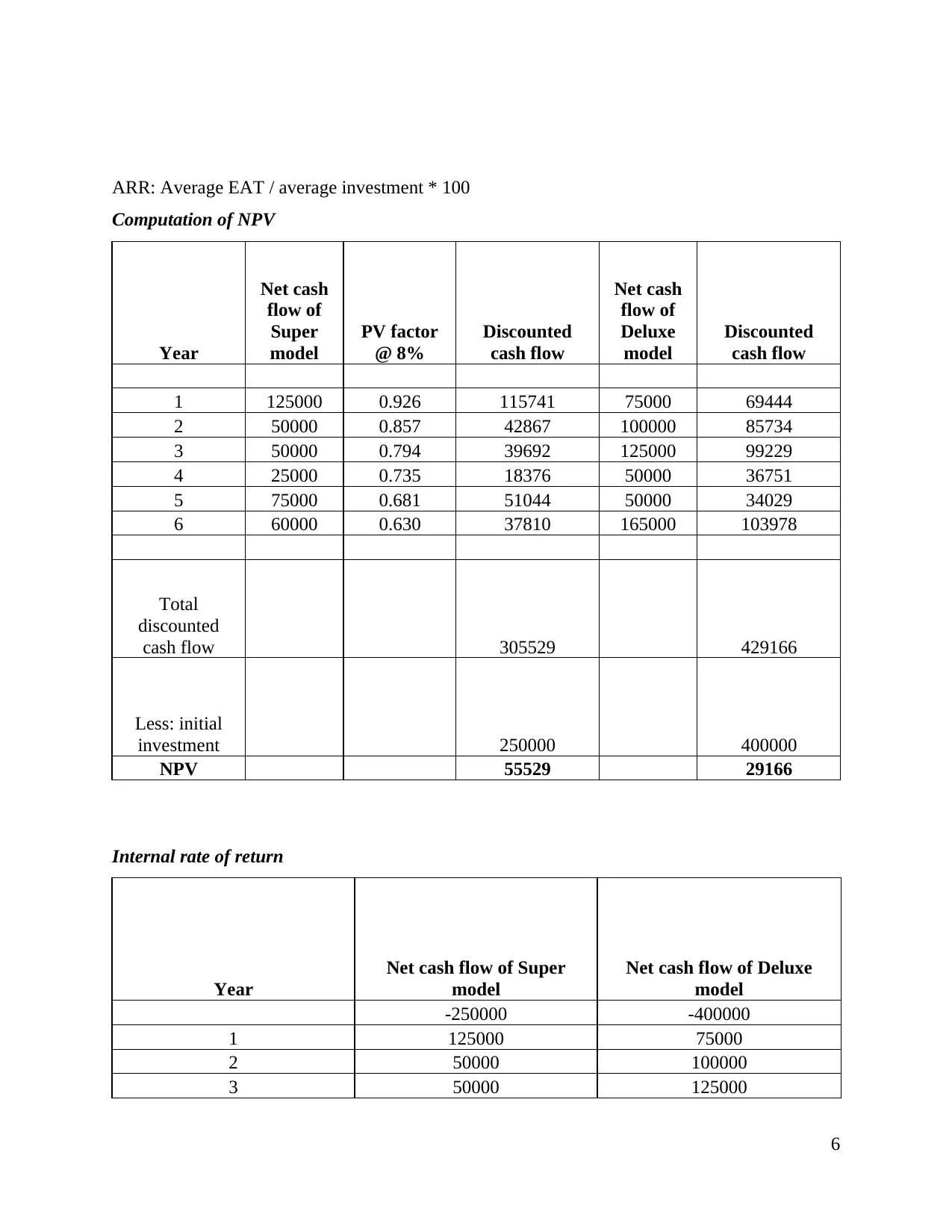
ARR: Average EAT / average investment * 100
Computation of NPV
Year
Net cash
flow of
Super
model
PV factor
@ 8%
Discounted
cash flow
Net cash
flow of
Deluxe
model
Discounted
cash flow
1 125000 0.926 115741 75000 69444
2 50000 0.857 42867 100000 85734
3 50000 0.794 39692 125000 99229
4 25000 0.735 18376 50000 36751
5 75000 0.681 51044 50000 34029
6 60000 0.630 37810 165000 103978
Total
discounted
cash flow 305529 429166
Less: initial
investment 250000 400000
NPV 55529 29166
Internal rate of return
Year
Net cash flow of Super
model
Net cash flow of Deluxe
model
-250000 -400000
1 125000 75000
2 50000 100000
3 50000 125000
6
Computation of NPV
Year
Net cash
flow of
Super
model
PV factor
@ 8%
Discounted
cash flow
Net cash
flow of
Deluxe
model
Discounted
cash flow
1 125000 0.926 115741 75000 69444
2 50000 0.857 42867 100000 85734
3 50000 0.794 39692 125000 99229
4 25000 0.735 18376 50000 36751
5 75000 0.681 51044 50000 34029
6 60000 0.630 37810 165000 103978
Total
discounted
cash flow 305529 429166
Less: initial
investment 250000 400000
NPV 55529 29166
Internal rate of return
Year
Net cash flow of Super
model
Net cash flow of Deluxe
model
-250000 -400000
1 125000 75000
2 50000 100000
3 50000 125000
6
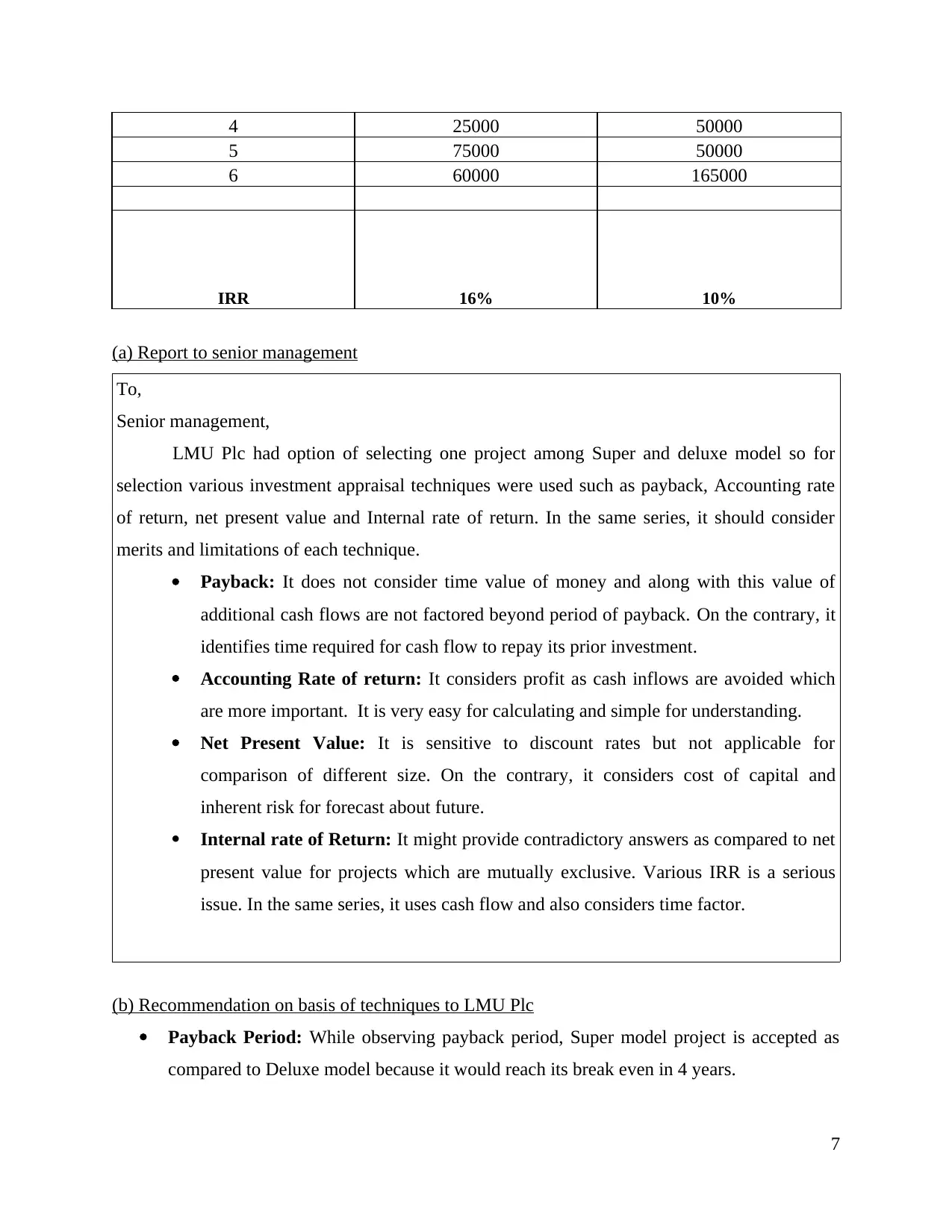
4 25000 50000
5 75000 50000
6 60000 165000
IRR 16% 10%
(a) Report to senior management
To,
Senior management,
LMU Plc had option of selecting one project among Super and deluxe model so for
selection various investment appraisal techniques were used such as payback, Accounting rate
of return, net present value and Internal rate of return. In the same series, it should consider
merits and limitations of each technique.
Payback: It does not consider time value of money and along with this value of
additional cash flows are not factored beyond period of payback. On the contrary, it
identifies time required for cash flow to repay its prior investment.
Accounting Rate of return: It considers profit as cash inflows are avoided which
are more important. It is very easy for calculating and simple for understanding.
Net Present Value: It is sensitive to discount rates but not applicable for
comparison of different size. On the contrary, it considers cost of capital and
inherent risk for forecast about future.
Internal rate of Return: It might provide contradictory answers as compared to net
present value for projects which are mutually exclusive. Various IRR is a serious
issue. In the same series, it uses cash flow and also considers time factor.
(b) Recommendation on basis of techniques to LMU Plc
Payback Period: While observing payback period, Super model project is accepted as
compared to Deluxe model because it would reach its break even in 4 years.
7
5 75000 50000
6 60000 165000
IRR 16% 10%
(a) Report to senior management
To,
Senior management,
LMU Plc had option of selecting one project among Super and deluxe model so for
selection various investment appraisal techniques were used such as payback, Accounting rate
of return, net present value and Internal rate of return. In the same series, it should consider
merits and limitations of each technique.
Payback: It does not consider time value of money and along with this value of
additional cash flows are not factored beyond period of payback. On the contrary, it
identifies time required for cash flow to repay its prior investment.
Accounting Rate of return: It considers profit as cash inflows are avoided which
are more important. It is very easy for calculating and simple for understanding.
Net Present Value: It is sensitive to discount rates but not applicable for
comparison of different size. On the contrary, it considers cost of capital and
inherent risk for forecast about future.
Internal rate of Return: It might provide contradictory answers as compared to net
present value for projects which are mutually exclusive. Various IRR is a serious
issue. In the same series, it uses cash flow and also considers time factor.
(b) Recommendation on basis of techniques to LMU Plc
Payback Period: While observing payback period, Super model project is accepted as
compared to Deluxe model because it would reach its break even in 4 years.
7
⊘ This is a preview!⊘
Do you want full access?
Subscribe today to unlock all pages.

Trusted by 1+ million students worldwide
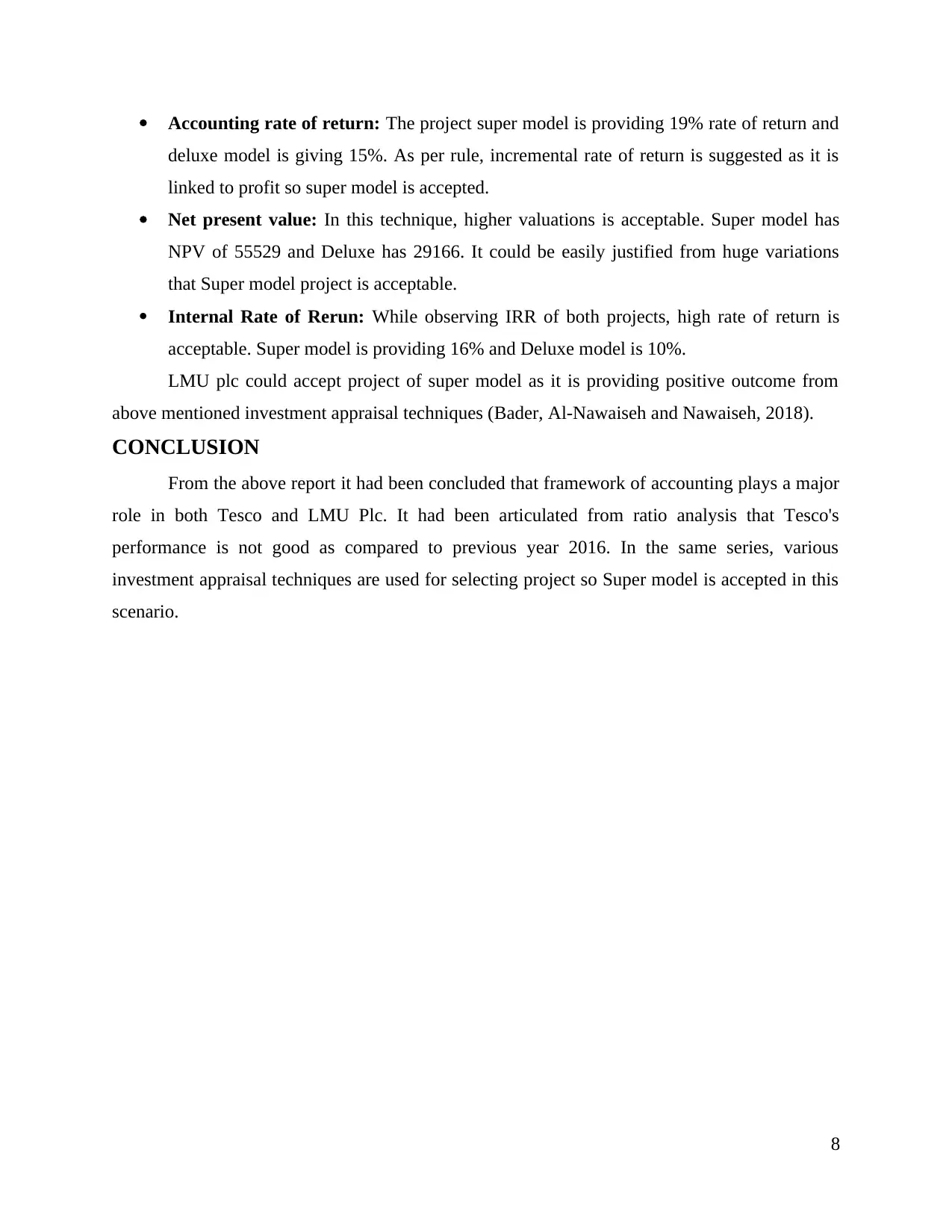
Accounting rate of return: The project super model is providing 19% rate of return and
deluxe model is giving 15%. As per rule, incremental rate of return is suggested as it is
linked to profit so super model is accepted.
Net present value: In this technique, higher valuations is acceptable. Super model has
NPV of 55529 and Deluxe has 29166. It could be easily justified from huge variations
that Super model project is acceptable.
Internal Rate of Rerun: While observing IRR of both projects, high rate of return is
acceptable. Super model is providing 16% and Deluxe model is 10%.
LMU plc could accept project of super model as it is providing positive outcome from
above mentioned investment appraisal techniques (Bader, Al-Nawaiseh and Nawaiseh, 2018).
CONCLUSION
From the above report it had been concluded that framework of accounting plays a major
role in both Tesco and LMU Plc. It had been articulated from ratio analysis that Tesco's
performance is not good as compared to previous year 2016. In the same series, various
investment appraisal techniques are used for selecting project so Super model is accepted in this
scenario.
8
deluxe model is giving 15%. As per rule, incremental rate of return is suggested as it is
linked to profit so super model is accepted.
Net present value: In this technique, higher valuations is acceptable. Super model has
NPV of 55529 and Deluxe has 29166. It could be easily justified from huge variations
that Super model project is acceptable.
Internal Rate of Rerun: While observing IRR of both projects, high rate of return is
acceptable. Super model is providing 16% and Deluxe model is 10%.
LMU plc could accept project of super model as it is providing positive outcome from
above mentioned investment appraisal techniques (Bader, Al-Nawaiseh and Nawaiseh, 2018).
CONCLUSION
From the above report it had been concluded that framework of accounting plays a major
role in both Tesco and LMU Plc. It had been articulated from ratio analysis that Tesco's
performance is not good as compared to previous year 2016. In the same series, various
investment appraisal techniques are used for selecting project so Super model is accepted in this
scenario.
8
Paraphrase This Document
Need a fresh take? Get an instant paraphrase of this document with our AI Paraphraser

REFERENCES
Books and Journals:
Alper, K., and et. al., 2018. Reserve requirements, liquidity risk, and bank lending
behavior. Journal of Money, Credit and Banking. 50(4). pp.817-827.
Bader, A., Al-Nawaiseh, H. N. and Nawaiseh, M. E., 2018. Capital Investment Appraisal
Practices of Jordan Industrial Companies: A Survey of Current Usage. International
Research Journal of Applied Finance. 9(4). pp.146-161.
Deng, S. and et. al., 2018. Loan sales and borrowers’ accounting conservatism. Contemporary
Accounting Research. 35(2). pp.1166-1194.
Kızıl, C., Kaşbaşı, B. and Kızıl, C., 2018. Original Paper Accounting Scandals and Eye-Catching
Frauds: USA-Japan Comparison by Considering the Role of Auditing. Journal of Asian
Research. 2(3).
Online:
Tesco Annual report and Financial Statements. 2017. [Online]. Available through:
<https://www.tescoplc.com/media/392373/68336_tesco_ar_digital_interactive_250417.pdf>.
Tesco Strategic Report. 2016. [Online]. Available through:
<https://www.tescoplc.com/media/264195/strategic-report-2016.pdf>.
9
Books and Journals:
Alper, K., and et. al., 2018. Reserve requirements, liquidity risk, and bank lending
behavior. Journal of Money, Credit and Banking. 50(4). pp.817-827.
Bader, A., Al-Nawaiseh, H. N. and Nawaiseh, M. E., 2018. Capital Investment Appraisal
Practices of Jordan Industrial Companies: A Survey of Current Usage. International
Research Journal of Applied Finance. 9(4). pp.146-161.
Deng, S. and et. al., 2018. Loan sales and borrowers’ accounting conservatism. Contemporary
Accounting Research. 35(2). pp.1166-1194.
Kızıl, C., Kaşbaşı, B. and Kızıl, C., 2018. Original Paper Accounting Scandals and Eye-Catching
Frauds: USA-Japan Comparison by Considering the Role of Auditing. Journal of Asian
Research. 2(3).
Online:
Tesco Annual report and Financial Statements. 2017. [Online]. Available through:
<https://www.tescoplc.com/media/392373/68336_tesco_ar_digital_interactive_250417.pdf>.
Tesco Strategic Report. 2016. [Online]. Available through:
<https://www.tescoplc.com/media/264195/strategic-report-2016.pdf>.
9

10
⊘ This is a preview!⊘
Do you want full access?
Subscribe today to unlock all pages.

Trusted by 1+ million students worldwide
1 out of 12
Related Documents
Your All-in-One AI-Powered Toolkit for Academic Success.
+13062052269
info@desklib.com
Available 24*7 on WhatsApp / Email
![[object Object]](/_next/static/media/star-bottom.7253800d.svg)
Unlock your academic potential
© 2024 | Zucol Services PVT LTD | All rights reserved.





